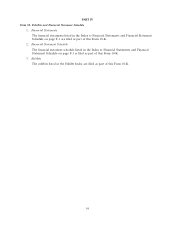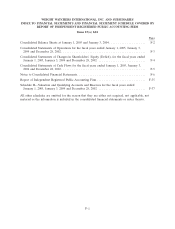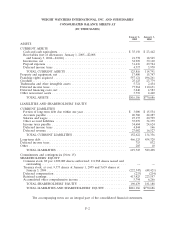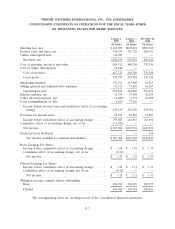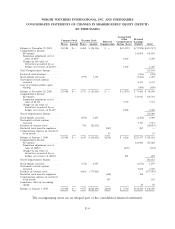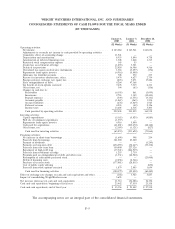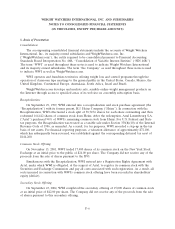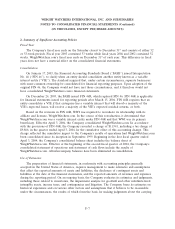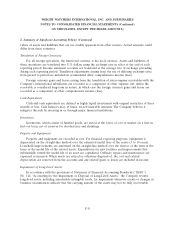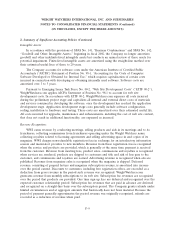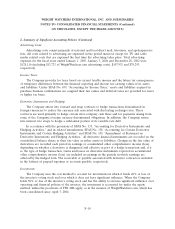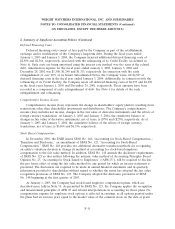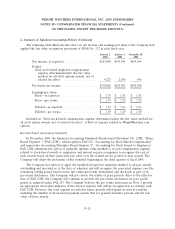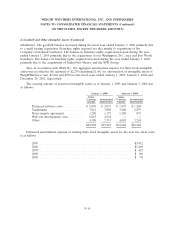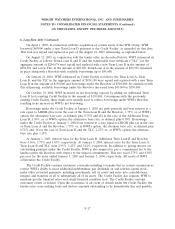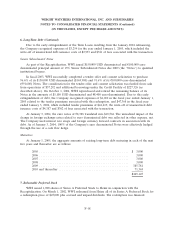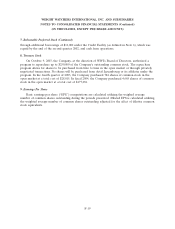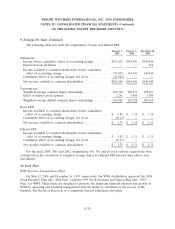WeightWatchers 2004 Annual Report Download - page 72
Download and view the complete annual report
Please find page 72 of the 2004 WeightWatchers annual report below. You can navigate through the pages in the report by either clicking on the pages listed below, or by using the keyword search tool below to find specific information within the annual report.WEIGHT WATCHERS INTERNATIONAL, INC. AND SUBSIDIARIES
NOTES TO CONSOLIDATED FINANCIAL STATEMENTS (Continued)
(IN THOUSANDS, EXCEPT PER SHARE AMOUNTS)
2. Summary of Significant Accounting Policies (Continued)
Advertising Costs:
Advertising costs consist primarily of national and local direct mail, television, and spokesperson’s
fees. All costs related to advertising are expensed in the period incurred, except for TV and radio
media related costs that are expensed the first time the advertising takes place. Total advertising
expenses for the fiscal years ended January 1, 2005, January 3, 2004 and December 28, 2002 were
$128,116 (including $13,723 of WeightWatchers.com advertising costs), $107,931 and $78,293,
respectively.
Income Taxes:
The Company provides for taxes based on current taxable income and the future tax consequences
of temporary differences between the financial reporting and income tax carrying values of its assets
and liabilities. Under SFAS No. 109, ‘‘Accounting for Income Taxes,’’ assets and liabilities acquired in
purchase business combinations are assigned their fair values and deferred taxes are provided for lower
or higher tax bases.
Derivative Instruments and Hedging:
The Company enters into forward and swap contracts to hedge transactions denominated in
foreign currencies to reduce the currency risk associated with fluctuating exchange rates. These
contracts are used primarily to hedge certain inter-company cash flows and for payments arising from
some of the Company’s foreign currency denominated obligations. In addition, the Company enters
into interest rate swaps to hedge a substantial portion of its variable rate debt.
In accordance with the provisions of SFAS No. 133, ‘‘Accounting for Derivative Instruments and
Hedging Activities,’’ and its related amendments, SFAS No. 138, ‘‘Accounting for Certain Derivative
Instruments and Certain Hedging Activities’’ and SFAS No. 149, ‘‘Amendment of Statement on
Derivative Instruments and Hedging Activities,’’ all derivative financial instruments are recorded on the
consolidated balance sheets at their fair value as either assets or liabilities. Changes in the fair value of
derivatives are recorded each period in earnings or accumulated other comprehensive income (loss),
depending on whether a derivative is designated and effective as part of a hedge transaction and, if it
is, the type of hedge transaction. Gains and losses on derivative instruments reported in accumulated
other comprehensive income (loss) are included in earnings in the periods in which earnings are
affected by the hedged item. The receivable or payable associated with derivative contracts is included
in the balance of prepaid expenses or accounts payable, respectively.
Investments:
The Company uses the cost method to account for investments in which it holds 20% or less of
the investee’s voting stock and over which it does not have significant influence. When the Company
holds 50% or less of the investee’s voting stock and has the ability to exercise significant influence over
operating and financial policies of the investee, the investment is accounted for under the equity
method, unless the provisions of FIN 46R apply, as in the instance of WeightWatchers.com, which has
been consolidated since April 3, 2004.
F-10


